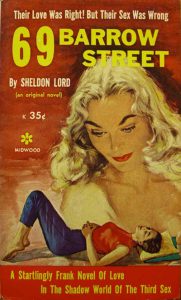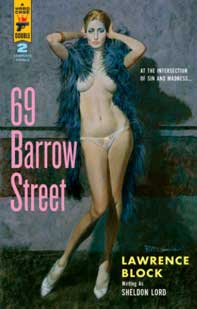 69 Barrow Street, by Lawrence Block writing as Sheldon Lord, Tower, 1959
69 Barrow Street, by Lawrence Block writing as Sheldon Lord, Tower, 1959
Cover Line: “Their Love was Right! But Their Sex Was Wrong!”
We’ve all known them: the men who long to be lesbians. in the days before they found an outlet for their frustrated desires by dominating the discussions in women studies classes with passionate paeans to Monique Wittig, they wrote lesbian pulp.
Does Lawrence Block belong to this esoteric tribe? One thing is for sure: before becoming an Edgar Award-winning mystery author, Block wrote an awful lot of lesbian pulp. Sure, I realize that many male writers paid their dues in this grove of the pulp jungle, penning scenes of lesbian action purely because sleaze fans expected it. But Block seems more enthusiastic than his pulp brothers. His first book, written as Lesley Evans, was a lesbian pulp called Strange Are the Ways of Love (Crest, 1959). Per the website Vintage Sleaze he also wrote the faux sexology book The Lesbian: a frank, revealing study of women who turn to their own sex for love, under the name Dr. Benjamin Morse. His 1965 pulp, Enough of Sorrow (written as Jill Emerson) was even excerpted in the Cleis anthology, Lesbian Pulp Fiction (edited by Katherine V. Forrest).
So where on the I-wanna-be-a-lesbian Kinsey scale did Block fall? Only he can say. In any case, his lesbian pulp oeuvre shouldn’t be judged on the basis of 69 Barrow Street, which is not his best pulp–although it does a nice job exploiting America’s fevered fantasies of beatnik depravity. In Block’s version of the Village, the lesbian is the goody two-shoes. Her deviance pales beside that of her neighbor, a sado-masochistic femme fatale.
The Plot: This is the story of sick, perverted, depraved people. The reader knows this, because the word “sick” appears five times in the first chapter alone. Greenwich Village is home to “the sick ones,” all manner of decadent, twisted, losers, and phonies.
More specifically, it’s home to Ralph and Stella, who share an apartment at the titular address. Ralph used to be a painter, but now he’s little more than Stella’s boy-toy. And Stella? Oh Stella. Stella is a beautiful, big-breasted blond sex-fiend who funds her depraved sex and drug orgies with a trust fund. When lesbian Susan moves in upstairs, fresh from breaking up with her girlfriend, both Ralph and Stella eye her with interest.
Ralph figures Susan for a lesbian but he likes her as a friend. She makes him want to paint again, and pull himself together. Stella just wants to satisfy her lust with Susan, but she’s too busy organizing a marijuana and sex orgy to really pursue her. Susan has the hots for Stella, but finds her disturbing.
Then there’s the orgy, about thirty pages of plotless titillation. And not terribly titillating — it seems like one of those parties where no one has a very good time, that nonetheless go on forever.
Post orgy, Ralph realizes he has to find a way out of this “pitfall of perversion.” Since Stella is occupied with the s/m relationship she’s started with Maria, a guest at the orgy, Ralph has the inside track on Susan. He begins to paint her portrait and falls in love with her. Susan swiftly realizes she loves Ralph too, but the idea of sex with him frightens and repels her. Susan decides to give Stella a go, and headsdown to her apartment. Stella welcomes her — Stella’s always in the mood — but, just as things are getting hot and heavy, Susan changes her mind. “You mean you’re going to leave me like this–all steamed up with no place to go?” demands Stella. “That’s what you think…I’m going to have you, sister, even if I have to rape you in order to get you!” Alarmed by Stella’s threat, Susan conks her downstairs neighbor with a lamp and beats a retreat to her own apartment where she has rapturous sex with Ralph.
But hell hath no fury like a woman scorned, right? Who’s that creeping up the stairs with a butcher knife? Why, Stella of course. Ralph’s gone out on some errand or other, so Susan has to do some fast talking. Fortunately, Stella’s gone completely bonkers at this point, and slashes the portrait of Susan, under the misconception that she’s killing the flesh and blood woman. Then she herself is sliced up by Maria, who’s also been driven psychotic by too much s/m role play. The price of sexual experimentation is pretty steep in this book.
Ralph and Susan fall into each one another’s arms and resolve to flee the evil Village, blissfully unaware that they’ll never be able to afford that apartment on Barrow Street again.
Sex: Partner swapping at the orgy, “Greek style” as well as “French style” (I had to look that one up). There’s even some man-on-man action between two characters named Roger and Jimmy, which begins with Roger saying, “You know, sometimes I get pretty fed up with women. You know what I mean?” And ends with him asking Jimmy, “How did you like it?” Jimmy: “I like it better with women.” Roger: “Naturally. So do I.” When Susan and Ralph finally consummate their love, the sex is described in a way that’s almost, well, lesbian: “It was all so good and so beautiful, all so perfect and so wonderful….And she knew a peace that she hadn’t believed existed.”
Drugs: The book offers a handy how-to on getting high: “She dragged deeply on the joint with her lips slightly parted so that she would smoke it properly, taking in a mixture of air and smoke. She drew the mixture directly into her lungs in order to get the maximum effect, rather than puffing on it and then inhaling as with a regular cigarette.”
Homo Psychology: Susan may refer to herself as a “freak”, but the book presents her as a well-adjusted lesbian. She’s a woman who’s sexually attracted to women; falling for Ralph is an exception to the rule rather than a return to normality.
Booklist, on the reissue: “69 Barrow Street, originally published in 1961 under the name Sheldon Lord, is the kind of smutty pulp novel that would have remained lost in the thrift-store spinner racks if not for two facts. One, Sheldon Lord went on to become Lawrence Block, and two, it’s actually kind of good.”
My take: I’m not sure it’s good, even kind of, but the book is interesting. The moral message is as twisted and confused as those mixed up Greenwich Village denizens. Better a decent lesbian from Brooklyn than a blonde nymphomaniac with a trust fund? Stay away from Greenwich Village? Gender doesn’t matter, character does? I can envision a post-modern queer lit class where students make a case for an against the grain reading of Ralph as the book’s real lesbian protagonist–sexually dominated by the evil Stella, then saved by the love of a good lesbian. It’s the plot of several of Paula Christian’s pulps, except that she features all female triangles and Ralph is, technically, a man.There’s lots of lit theory fun to be had with this book.
And one final comment on our original wannabe lesbian, Lawrence Block. At some point in late 1999 or early 2000 Block was a guest on Fresh Air along with Ann Bannon. Like any good lesbian, he cites Bannon, Ann Aldrich and Vin Packer (the latter two are both Marijane Meaker) as seminal influences. He is fond of recounting this anecdote about that experience: “During a break, Terry said to me, ‘But Larry, you’re not actually a lesbian.’ ‘Terry,’ I said, ‘that’s only an accident of birth.'” (SOURCE: http://pulpbuzz.wordpress.com/2013/12/06/guest-post-my-life-as-a-lesbian-by-lawrence-block)

